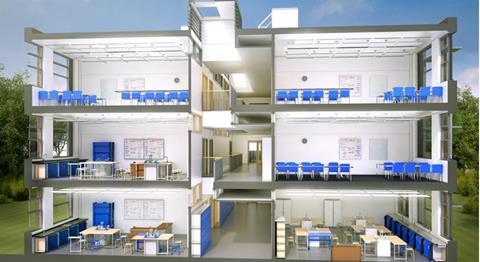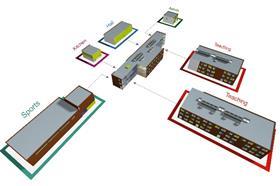But Education Funding Agency says any alternatives must hit cost benchmark

Contractors and architects will be free to work up their own designs for schools as part of the government’s flagship schools building programme, so long as they improve on the baseline guidelines published yesterday.
The long-awaited baseline design guidance, published by the Department for Education (DfE), sets out basic design guidance for two secondary schools for 1,200 pupils and a primary school for 420 pupils.
The move came in response to Sebastian James’ review of education capital and forms a key part of the government’s plan to cut 30% of the cost of school building through greater standardisation in the design and build process.
As first revealed by Building in February, the designs see a reduction of the overall gross area averaging 15% in secondary schools and 5% in primary schools.
The DfE said the designs could realise up to £6m in savings per secondary school compared to the previous government’s Building Schools for the Future programme - and with 100 secondary schools in the PSBP that could lead to as much as £600m in savings.
The DfE said the savings on the 139 primaries and 20 all through all specials schools in the programme would be less than on the secondary schools.
Schools capital body the Education Funding Agency insisted yesterday that the designs were very much a “starting point” and contractors and architects could continue to innovate within the new parameters.
Mike Green, EFA director of capital said further baseline designs would be published for different curricular and different primary schools before the end of the year.
He said architects and contractors could develop the baselines designs into detailed schemes or propose alternatives. “It will not be compulsory to use the baseline designs on all projects at this time. There purpose is to give an example for the kind of school buildings the government is seeking to procure,” he said.
“We know many contractors have been working on their own version of baselines designs and sharing their thinking with us - this gives them the freedom to adjust the internal layout to meet the needs of the pupils.”

He said the baseline designs would be implemented for the £2bn PFI element of the Priority Schools Building Programme, but existing specifications within the EFA’s existing framework would continue to apply for the £400m worth of directly-funded schools that form the first part of the PSBP.
He said: “The baseline designs are much more aimed at the PFI element, which comes out around Christmas time. However, what we are saying for the capital element is it’s very much aimed at working toward those.
“We would like to think that contractors and architects will see our direction of travel and adopt as much or as little as they think suitable.”
However, Green was clear that any alternatives proposed by design and build teams would need to be an improvement on the EFA’s baseline designs - and anything more expensive than the baseline cost of £1,465 per sq/m would not be approved. “We we’re not keen for anyone to come up with anything more expensive, of course,” he said.
“We are interested in more great schools for as little money as possible. That is the fundamental driver of this.
“Any alternative suggested will have to be better - or we will have no reason to pick it. We’re not trying to restrict things - quite the reverse. There may be some kind of competitive advantage people can gain by doing something slightly different, but I don’t think we’re expecting something that is going to leap us forward 50 years in school design.
“There is innovation there to be had. But if someone suggests some alternative then you would expect it to be better than what we’re already doing.”
He said the baseline designs had aimed to strike a balance between standardisation and unique designs.”If we can allow an element of standardisation where many components are similar, as opposed to unique, then clearly we will get efficiency,” he said.
“We get that people have to work and people have to make profits but we’re not into designing everything uniquely and from scratch. I guess we’re trying to get a way down the road, as it were, before unique things come into play rather than starting with everything from scratch.”
“This is for me absolutely about more schools - we want great schools of course we do, but, and I don’t like the word cheap, but the more efficiently we can deliver them the more schools we can get.”




























No comments yet